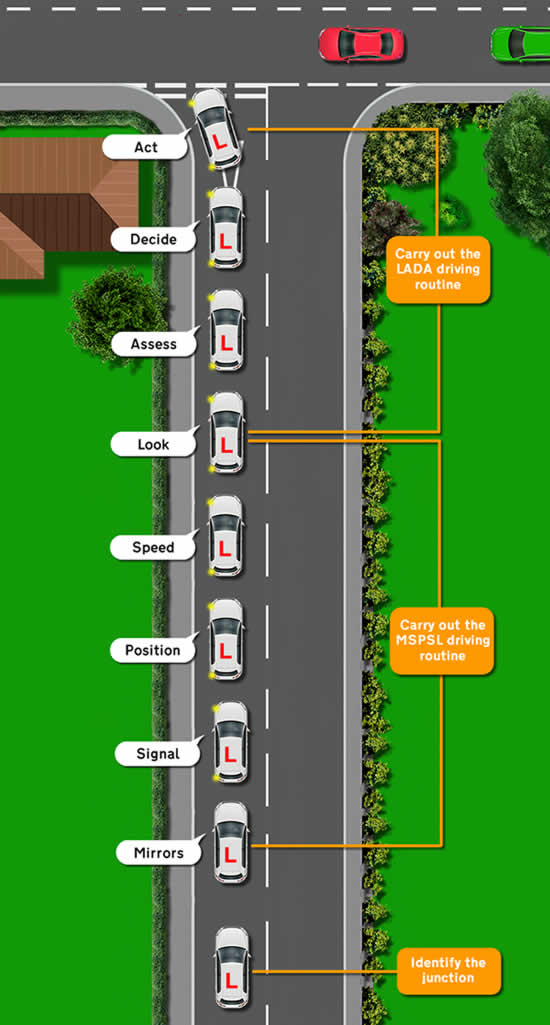In this tutorial, we explain how to correctly make a left turn at a T-junction in an automatic car. Use the following technique for turning left at all T-junctions types, whilst learning to drive and also during your practical driving test.
Identify the T-junction
We’ve already covered how to identify a T-junction. It’s important to identify the T-junction as early as possible as this allows you to gauge its distance so that you can begin the MSPSL routine, but it also allows you to identify the type of junction. As you approach the T-junction, you’ll need to identify whether the junction is:
- Open
- Closed
- Marked (give way or stop junction? See T-junction road markings)
- Unmarked
- Controlled (are there advanced stop lines?)

Begin the MSPSL Driving Routine
We now begin the MSPSL driving routine. MSPSL stands for Mirrors, Signal, Position, Speed and Look. Use the following procedure for turning left at a T-junction:
Mirrors
When driving, you always need to know what’s going on around you and that it’s safe, particularly before changing speed or direction. When making a left turn at a T-junction, first check your interior mirror and because we are turning left, then check your left door mirror.
Signal
For safety reasons, it’s important that we let other road users and pedestrians know where we intend on going. Because we’re turning left at the T-junction, we now need to signal left.
Position
If the road is reasonably wide, move over to the left side of the road as this may allow cars that are turning right to pull up alongside you when you arrive at the junction. If the road isn’t very wide, simply maintain your normal driving position.
Speed
Your speed will relate to when you began identifying the junction at the start. Speed if often a cause of many driving test failures at junctions due to the test candidate approaching a junction at an inappropriate speed for the type of T-junction.
If the T-junction is closed for example (you can see very little of the major road as you approach), then you’ll likely need to approach much more slowly than if the junction open (you can see the major road and traffic on the road well in advance). The slower you approach a T-junction, the more time it’ll give you to observe and react. It’s better to be a little too cautious than not cautious enough.
As you approach the junction, cover the brake and if the junction is closed, slow down to an appropriate speed that allows you to observe and react to what’s going on ahead. Being as we are in an automatic car, gears are changed down automatically. To adjust our speed, all we need to do is cover the brake (the car will automatically slow down due to engine braking) and if we need to reduce speed faster, apply progressive braking (see how to brake smoothly in an automatic car).
Look
‘Look’ is at the end of the MSPSL routine and the beginning of the LADA driving routine. At this point you should have identified the type of junction that’s in front of you, so now we need to look at traffic on the major road and also look for potential or actual hazards.
As you approach the T-junction, look at traffic on the major road. Quickly alternate your observations from left, to where you’re going, over to the right, back to where you’re going and to the left. Situations quickly change on the roads, so continue alternating your observations and don’t stop. Even though you are turning left and giving way to traffic on the right, you still need to check left. There could be hazards such as parked cars on the major road or perhaps an overtaking vehicle that’s in the lane you intend on joining.
You also need to be looking for pedestrians that are waiting or about to cross the road in front of you. If a pedestrian is waiting to cross and if it’s safe to do so, stop and allow them to cross. Avoid gesturing the pedestrian as this may cause them to act without taking safety observations. For further information, see pedestrians crossing at junctions.
Finally, don’t forget to look directly in front of you at where you’re going. As you get closer to the T-junction, you also need to be looking for road markings as you’ll need to avoid going over lines if you stop. Stopping so that the front of your car is over the give way road markings and into the junction will almost certainly fail a driving test.
Assess
We now need to assess everything that we could see when we were looking. There’s a lot to look at and take in when approaching T-junctions, so remember, this is all relative to speed – if you’re going too fast you’ll not have time to properly look.
Decide
Now that we are almost at the T-junction, we’ve assessed what’s going on so we need to make a decision. It’s important to be decisive and confident in your actions.
Act
Finally, we act on our decision, whether that be continue to emerge from the T-junction to turn left without stopping, or whether to stop to give way or stop due to it being a closed junction or a stop junction. If you’re in any doubt on what to do then avoid taking any risks and stop. For further information, see do you always have to stop at a T-junction?
As we approach the junction, follow the kerbline round to the left. Following the kerbline round to the left will give you a better road position when you join the major road. Keeping to the left also means that if you do stop, another vehicle may stop alongside you for turning right (if the road is wide enough).